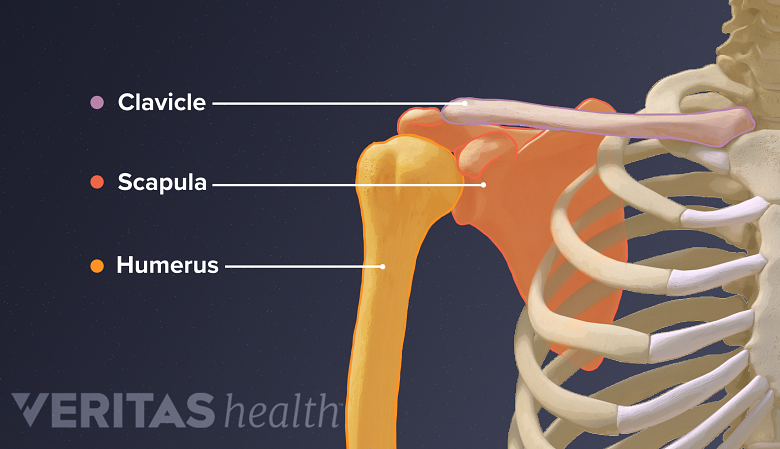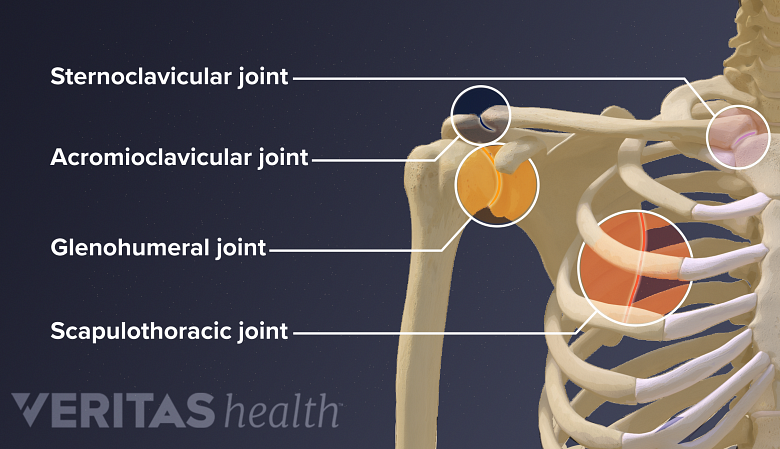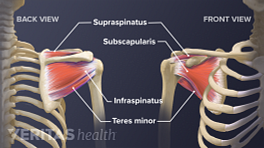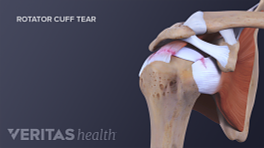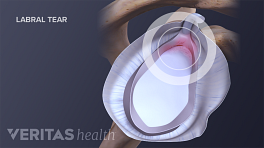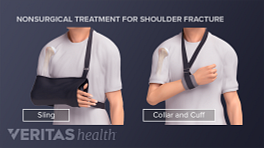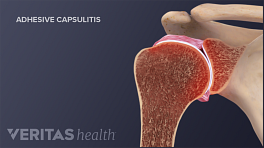The shoulder joint is one of the most complex and flexible joints in the body. This joint helps connect the upper arm to the rest of the body. 1 Miniato MA, Anand P, Varacallo M. Anatomy, Shoulder and Upper Limb, Shoulder. In: StatPearls. StatPearls Publishing; 2023. Accessed July 27, 2023. http://www.ncbi.nlm.nih.gov/books/NBK536933/
The interaction of bones and soft tissues around the shoulder endows it with flexibility, facilitating movements in several directions and planes. This high degree of flexibility also makes the shoulder highly susceptible to injuries and dislocation.
In This Article:
- Guide to Shoulder Anatomy
- Soft Tissues of the Shoulder
Bones of the Shoulder
The shoulder joint is formed by the interaction of 3 bones.
The shoulder is made up of three bones that intersect with each other: the humerus (upper arm bone), the scapula (shoulder blade), and the clavicle (collarbone). The shoulder blade and collarbone together form the shoulder girdle – which connects to the upper arm bone, providing a bony link between the trunk and the upper extremities.
- The upper arm bone is the largest bone in the arm and lies between the shoulder and the elbow. The upper part of this bone articulates with the shoulder blade, and the lower end of the bone forms the elbow joint with the forearm bone. 2 Mostafa E, Imonugo O, Varacallo M. Anatomy, Shoulder and Upper Limb, Humerus. In: StatPearls. StatPearls Publishing; 2023. Accessed July 28, 2023. http://www.ncbi.nlm.nih.gov/books/NBK534821/
- The shoulder blade is a large, flat, triangular bone that lies at the back of the upper rib cage. Several different muscles attach to the shoulder blade, which facilitates the stability and mobility of the shoulder joint. 3 Cowan PT, Mudreac A, Varacallo M. Anatomy, Back, Scapula. In: StatPearls. StatPearls Publishing; 2023. Accessed July 28, 2023. http://www.ncbi.nlm.nih.gov/books/NBK531475/
- The collarbone is a long S-shaped bone that forms a joint with the shoulder blade at one end and the sternum (breastbone) at the other end. The collarbone creates distance between the trunk and upper arm, allowing normal, free motion of the shoulder joint. 4 Hyland S, Charlick M, Varacallo M. Anatomy, Shoulder and Upper Limb, Clavicle. In: StatPearls. StatPearls Publishing; 2023. Accessed July 28, 2023. http://www.ncbi.nlm.nih.gov/books/NBK525990/
The interaction between these bones at the shoulder, along with muscles that attach to these bones, is responsible for the wide range of movements observed at the shoulder.
Shoulder Joints
The shoulder joint is formed by the union of 4 unique joints.
Although the term “shoulder joint” is generally used to refer to the ball-and-socket glenohumeral joint, the shoulder also consists of 3 other unique joints that together confer a wide range of motion.
The 4 joints of the shoulder are described below:
Glenohumeral joint
The glenohumeral joint is a ball and socket joint that connects the round head of the upper arm bone to a concave cavity, called the glenoid cavity, in the shoulder blade. 5 Chang LR, Anand P, Varacallo M. Anatomy, Shoulder and Upper Limb, Glenohumeral Joint. In: StatPearls. StatPearls Publishing; 2023. Accessed July 27, 2023. http://www.ncbi.nlm.nih.gov/books/NBK537018/
The shallowness of the glenoid cavity facilitates a wide range of motion at the glenohumeral joint, including the circular motion of the arm - making it one of the most mobile joints in the body. 1 Miniato MA, Anand P, Varacallo M. Anatomy, Shoulder and Upper Limb, Shoulder. In: StatPearls. StatPearls Publishing; 2023. Accessed July 27, 2023. http://www.ncbi.nlm.nih.gov/books/NBK536933/
The wide range of motion possible at the glenohumeral joint makes it the most frequently dislocated joint in the body. 1 Miniato MA, Anand P, Varacallo M. Anatomy, Shoulder and Upper Limb, Shoulder. In: StatPearls. StatPearls Publishing; 2023. Accessed July 27, 2023. http://www.ncbi.nlm.nih.gov/books/NBK536933/
See Shoulder Dislocation Injury
Sternoclavicular joint
The sternoclavicular joint is a saddle-shaped joint where the collarbone meets the upper part of the breastbone. 6 Epperson TN, Varacallo M. Anatomy, Shoulder and Upper Limb, Sternoclavicular Joint. In: StatPearls. StatPearls Publishing; 2023. Accessed July 28, 2023. http://www.ncbi.nlm.nih.gov/books/NBK537258/ The sternoclavicular joint is the only link between the shoulder girdle and the trunk.
This joint is well protected by a network of soft tissues that provide stability and support to the joint and allow free movement of the upper arm. 2 Mostafa E, Imonugo O, Varacallo M. Anatomy, Shoulder and Upper Limb, Humerus. In: StatPearls. StatPearls Publishing; 2023. Accessed July 28, 2023. http://www.ncbi.nlm.nih.gov/books/NBK534821/
Acromioclavicular joint
The acromioclavicular joint is where the acromion process, the highest point of the shoulder blade, meets the collarbone. 7 Wong M, Kiel J. Anatomy, Shoulder and Upper Limb, Acromioclavicular Joint. In: StatPearls. StatPearls Publishing; 2023. Accessed July 28, 2023. http://www.ncbi.nlm.nih.gov/books/NBK499858/ The acromioclavicular joint serves as the sole link between the arm and the core or axial skeleton. This joint helps disperse forces directed to the arm to the rest of the body and facilitates the motion of the shoulder blade.
The acromioclavicular joint facilitates arm movements away from the body – such as stretching the arms out or lifting the arm upward in front of the body. 3 Cowan PT, Mudreac A, Varacallo M. Anatomy, Back, Scapula. In: StatPearls. StatPearls Publishing; 2023. Accessed July 28, 2023. http://www.ncbi.nlm.nih.gov/books/NBK531475/
Scapulothoracic joint
The scapulothoracic joint is where the shoulder blade meets the rib cage. The scapulothoracic joint lacks the typical characteristics of a joint and is not considered a true joint. The scapulothoracic joint is considered a gliding joint that allows the surface of the scapula to slide against the wall of the rib cage. 4 Hyland S, Charlick M, Varacallo M. Anatomy, Shoulder and Upper Limb, Clavicle. In: StatPearls. StatPearls Publishing; 2023. Accessed July 28, 2023. http://www.ncbi.nlm.nih.gov/books/NBK525990/
The scapulothoracic joint helps orient the joint surfaces of the glenohumeral joint during upper arm movements.
Articular Cartilage of the Shoulder
The shoulder joints’ bony surfaces are covered in articular cartilage – a slippery, strong, and flexible material that allows smooth movements between the joint surfaces. 8 Almajed YA, Hall AC, Gillingwater TH, Alashkham A. Anatomical, functional and biomechanical review of the glenoid labrum. J Anat. 2022;240(4):761-771. doi:https://doi.org/10.1111/joa.13582
The articular cartilage has the following two main functions:
- It allows the joint surfaces to move or glide against one another in a smooth and pain-free manner.
- It cushions the bones from impacting one another by acting as a shock absorber during high-impact activities, such as tennis or gymnastics.
Articular cartilage is often thinner in the shoulder than it is in other weight-bearing joints, such as the knees and hips. 9 Chubinskaya S, Cotter EJ, Frank RM, Hakimiyan AA, Yanke AB, Cole BJ. Biologic Characteristics of Shoulder Articular Cartilage in Comparison to Knee and Ankle Articular Cartilage From Individual Donors. Cartilage. 2021;12(4):456-467. doi:10.1177/1947603519847740 When the articular cartilage in the shoulder is damaged, it can significantly affect the shoulder’s ability to withstand friction and impact.
The damage and loss of articular cartilage is called osteoarthritis. The glenohumeral joint and acromioclavicular joint are typically susceptible to this condition, with osteoarthritis of the acromioclavicular joint being more common. 10 Clavert P. Glenoid labrum pathology. Orthop Traumatol Surg Res. 2015;101(1, Supplement):S19-S24. doi:https://doi.org/10.1016/j.otsr.2014.06.028
Movements of the Ball and Socket Joint
The shoulder joint enables a wide range of movements.
Aided by the shoulder girdle, the glenohumeral joint is involved in the execution of a wide range of movements. Primary movements of the glenohumeral joint include 1 Miniato MA, Anand P, Varacallo M. Anatomy, Shoulder and Upper Limb, Shoulder. In: StatPearls. StatPearls Publishing; 2023. Accessed July 27, 2023. http://www.ncbi.nlm.nih.gov/books/NBK536933/ , 5 Chang LR, Anand P, Varacallo M. Anatomy, Shoulder and Upper Limb, Glenohumeral Joint. In: StatPearls. StatPearls Publishing; 2023. Accessed July 27, 2023. http://www.ncbi.nlm.nih.gov/books/NBK537018/ :
- Abduction: movement of the upper arms away from the body
- Adduction: movement of the upper arms toward the body
- Flexion: raising of the upper arm in front of the body
- Extension: moving the upper arm behind the body
- External rotation: outward rotation of the arm away from the body
- Internal rotation: inward rotation of the arm toward the body
- Horizontal abduction: movement of the upper arm in the horizontal plane away from the body
- Horizontal adduction: movement of the upper arm in the horizontal plane across the body
Each movement requires a specific set of muscles in the shoulder, back, chest, and upper arms to work together. As a result, dysfunction or weakness of any of these muscles can limit one or more of these movements.
- 1 Miniato MA, Anand P, Varacallo M. Anatomy, Shoulder and Upper Limb, Shoulder. In: StatPearls. StatPearls Publishing; 2023. Accessed July 27, 2023. http://www.ncbi.nlm.nih.gov/books/NBK536933/
- 2 Mostafa E, Imonugo O, Varacallo M. Anatomy, Shoulder and Upper Limb, Humerus. In: StatPearls. StatPearls Publishing; 2023. Accessed July 28, 2023. http://www.ncbi.nlm.nih.gov/books/NBK534821/
- 3 Cowan PT, Mudreac A, Varacallo M. Anatomy, Back, Scapula. In: StatPearls. StatPearls Publishing; 2023. Accessed July 28, 2023. http://www.ncbi.nlm.nih.gov/books/NBK531475/
- 4 Hyland S, Charlick M, Varacallo M. Anatomy, Shoulder and Upper Limb, Clavicle. In: StatPearls. StatPearls Publishing; 2023. Accessed July 28, 2023. http://www.ncbi.nlm.nih.gov/books/NBK525990/
- 5 Chang LR, Anand P, Varacallo M. Anatomy, Shoulder and Upper Limb, Glenohumeral Joint. In: StatPearls. StatPearls Publishing; 2023. Accessed July 27, 2023. http://www.ncbi.nlm.nih.gov/books/NBK537018/
- 6 Epperson TN, Varacallo M. Anatomy, Shoulder and Upper Limb, Sternoclavicular Joint. In: StatPearls. StatPearls Publishing; 2023. Accessed July 28, 2023. http://www.ncbi.nlm.nih.gov/books/NBK537258/
- 7 Wong M, Kiel J. Anatomy, Shoulder and Upper Limb, Acromioclavicular Joint. In: StatPearls. StatPearls Publishing; 2023. Accessed July 28, 2023. http://www.ncbi.nlm.nih.gov/books/NBK499858/
- 8 Almajed YA, Hall AC, Gillingwater TH, Alashkham A. Anatomical, functional and biomechanical review of the glenoid labrum. J Anat. 2022;240(4):761-771. doi:https://doi.org/10.1111/joa.13582
- 9 Chubinskaya S, Cotter EJ, Frank RM, Hakimiyan AA, Yanke AB, Cole BJ. Biologic Characteristics of Shoulder Articular Cartilage in Comparison to Knee and Ankle Articular Cartilage From Individual Donors. Cartilage. 2021;12(4):456-467. doi:10.1177/1947603519847740
- 10 Clavert P. Glenoid labrum pathology. Orthop Traumatol Surg Res. 2015;101(1, Supplement):S19-S24. doi:https://doi.org/10.1016/j.otsr.2014.06.028
